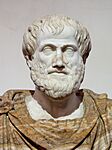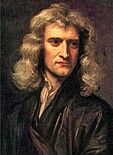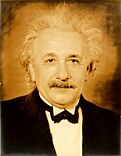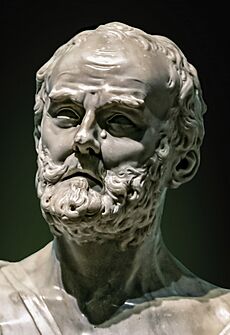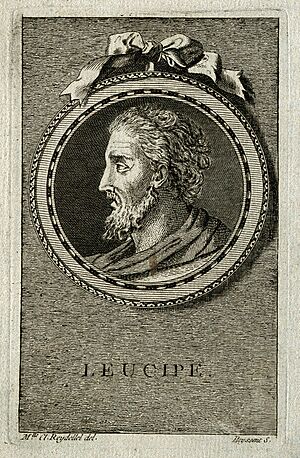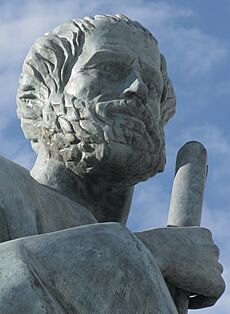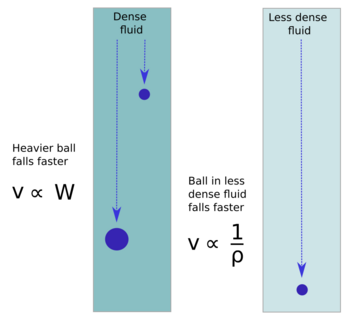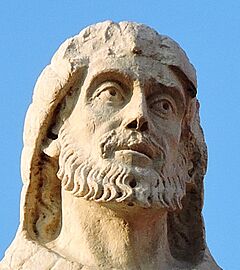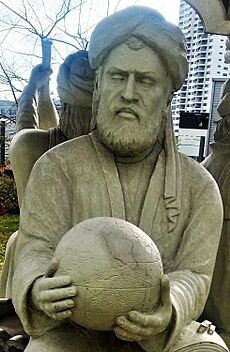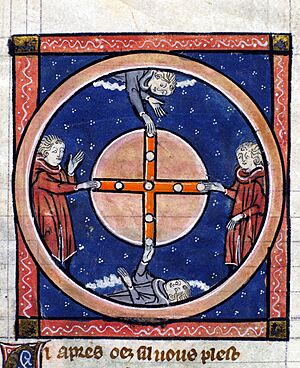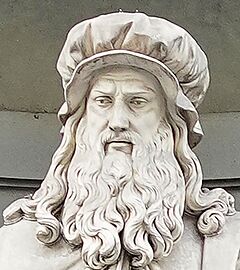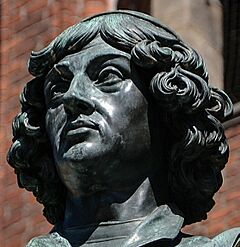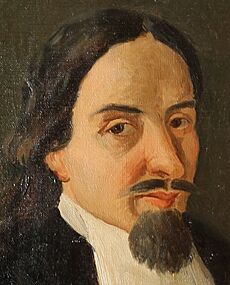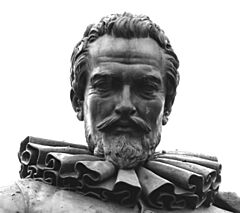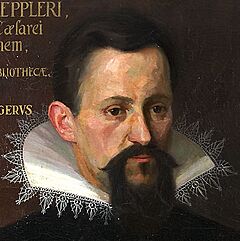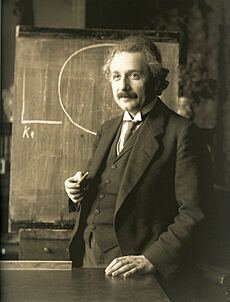History of gravitational theory facts for kids
Have you ever wondered why things fall down? Or why the Moon stays in orbit around the Earth? It's all thanks to something called gravity. In physics, theories of gravity try to explain how objects with mass pull on each other. People have been thinking about gravity for a very long time, even since ancient times!
The first ideas about gravity came from ancient Greek philosophy. Later, scientists in India, the Islamic world, and Europe added to these ideas. Big breakthroughs happened during the Scientific Revolution. This led to Isaac Newton's famous law of universal gravitation. But in the early 1900s, Albert Einstein came up with his theory of relativity, which changed how we understand gravity even more.
Let's explore how our understanding of gravity has changed over time.
Contents
- Ancient Ideas About Gravity
- Indian Contributions to Gravity
- Islamic World's Insights into Gravity
- European Renaissance Discoveries
- European Enlightenment and Newton
- Modern Era: Einstein and Beyond
- Images for kids
Ancient Ideas About Gravity
People in ancient times had many interesting ideas about why things fall.
Classical Thinkers
Heraclitus and Leucippus: Early Ideas of Cosmic Order
The Greek philosopher Heraclitus (around 535–475 BCE) believed in a special "law" or logos. He thought this law kept the whole cosmos (the universe) in balance. It made everything move, from the stars to the winds and waves.
Later, another ancient thinker named Leucippus (in the 5th century BCE) suggested that the universe began when tiny particles called atoms swirled together in a giant vortex. He thought smaller atoms formed the planets and stars. Larger atoms in the center came together to create the Earth.
Aristotle's View on Falling Objects
In the 4th century BCE, the Greek philosopher Aristotle taught that nothing moves without a reason. He believed heavy things like earth and water naturally moved downwards. They were drawn towards the center of the universe, which he thought was the center of the Earth. This was their "nature" or gravity. He also thought light things like fire and air naturally moved upwards.
Aristotle correctly observed that objects falling through a medium (like air or water) fall faster if they are heavier. They also fall slower if the medium is denser.
New Views on Weight and Motion
Greek philosopher Strato of Lampsacus (around 335–269 BCE) disagreed with Aristotle. He thought that objects don't get heavier as they fall. Instead, they hit harder because they gain speed.
Epicurus (around 341–270 BCE) believed that weight was a natural part of atoms. He thought atoms fell at the same speed in an empty space (a vacuum), no matter how heavy they were. This was because there was no air to slow them down.
The Greek astronomer Aristarchus of Samos (around 310–230 BCE) was one of the first to suggest that the Earth spins on its axis and orbits the Sun. This idea is called heliocentric cosmology. Later, Seleucus of Seleucia (around 190–150 BCE) supported this view. He also described how the Moon's gravity affects the ocean tides.
Archimedes and Buoyancy
The Greek physicist Archimedes (around 287–212 BCE) discovered the centre of mass for shapes like triangles. He also figured out that if you put an object in a liquid, the liquid pushes up on it. This upward push, called buoyant force, is equal to the weight of the liquid that the object moves out of the way.
Hipparchus, Lucretius, and Vitruvius on Falling Bodies
Greek astronomer Hipparchus of Nicaea (around 190–120 BCE) also disagreed with Aristotle. He thought that objects kept moving because of an "impetus" (a kind of push or force).
The Roman poet Lucretius (around 99–55 BCE) wrote that heavier objects fall faster in air because the air resists them less. But he believed that in a vacuum (empty space), all objects would fall at the same speed.
The Roman engineer Vitruvius (around 85–15 BCE) wrote that gravity doesn't just depend on how heavy something is. It depends on its "nature," or what we now call its specific gravity. He gave an example: "If quicksilver is poured into a vessel, and a stone weighing one hundred pounds is laid upon it, the stone swims on the surface... If we remove the hundred pound weight, and put on a tiny bit of gold, it will not swim, but will sink to the bottom... Hence, it is undeniable that the gravity of a substance depends not on the amount of its weight, but on its nature."
Plutarch, Pliny, and Ptolemy: Expanding Gravitational Ideas
The Greek philosopher Plutarch (around 46–120 CE) mentioned Roman astronomers who thought that gravity wasn't just on Earth. They even considered ideas like inertia (an object's resistance to changes in motion) and universal gravitation (gravity affecting all objects).
The effects of the Moon's gravity on the tides were also noted by Pliny the Elder (23–79 CE) and Claudius Ptolemy (100–170 CE).
Byzantine Era
John Philoponus and the Theory of Impetus
In the 6th century CE, a scholar from Alexandria named John Philoponus changed Aristotle's ideas. He suggested the "theory of impetus." This idea said that when you throw something, you give it a force or "impetus." This impetus makes it keep moving, but it slowly fades away.
Philoponus also wrote that if you drop two objects of different weights from the same height, they won't fall at speeds exactly matching their weights. He said the difference in their falling times would be very small.
Indian Contributions to Gravity
Scientists in India also thought deeply about gravity.
Brahmagupta's Attractive Force
The Indian mathematician and astronomer Brahmagupta (around 598–668 CE) was one of the first to describe gravity as an attractive force. He used the word "gurutvākarṣaṇam" to explain it:
"The earth on all its sides is the same; all people on the earth stand upright, and all heavy things fall down to the earth by a law of nature, for it is the nature of the earth to attract and to keep things, as it is the nature of water to flow..."
Bhāskarāchārya on Earth's Attraction
Another famous Indian mathematician and astronomer, Bhāskarā II (around 1114–1185), also described gravity as a natural attractive property of the Earth. He wrote:
"The property of attraction is inherent in the Earth. By this property the Earth attracts any unsupported heavy thing towards it: The thing appears to be falling but it is in a state of being drawn to Earth."
Islamic World's Insights into Gravity
Scholars in the Islamic world also made important contributions to understanding gravity.
Ibn Sina's Theory of Impetus
In the 11th century CE, the Persian scholar Ibn Sina (also known as Avicenna) agreed with Philoponus's idea of "impetus." He thought that a moving object gets an "inclination" or mayl from whatever pushed it. This mayl keeps the object moving until outside forces, like air resistance, make it stop.
The Iraqi scholar Ibn al-Haytham described gravity as a force that pulls heavier objects towards the center of the Earth. He also noted that this force only pulls towards the center, not in other directions.
Al-Biruni and Al-Khazini on Heavenly Bodies
Another Persian scholar from the 11th century, Al-Biruni, suggested that planets and stars also have mass, weight, and gravity, just like Earth. He disagreed with earlier ideas that only Earth had these properties.
In the 12th century, Al-Khazini thought that an object's gravity changes depending on how far it is from the center of the universe (which he meant as the center of the Earth). Both Al-Biruni and Al-Khazini studied the idea of the center of gravity and applied it to 3D objects. They also developed ways to measure the specific gravity of objects using special balances.
Abu'l-Barakāt al-Baghdādī's View on Motion
In the 12th century, Abu'l-Barakāt al-Baghdādī built on Ibn Sina's theory of impetus. He said that a "violent inclination" is given to a moving object. This inclination gets weaker as the object moves further from what pushed it. His ideas were an early step towards understanding acceleration in a way that was different from Aristotle's.
European Renaissance Discoveries
The Renaissance brought new ways of thinking and important experiments.
14th Century Ideas on Motion
Jean Buridan and the Oxford Calculators
In the 14th century, the French philosopher Jean Buridan and a group of scholars at Oxford called the Oxford Calculators rejected Aristotle's ideas about gravity. They thought that an object's motion was due to an "impetus" (like momentum), which depended on its speed and mass. Buridan was influenced by Ibn Sina's ideas.
Buridan and Albert of Saxony (around 1320–1390) believed that a falling object speeds up because its impetus increases. Albert also developed a rule about how the speed of a falling object relates to the time it has been falling.
Understanding Uniform and Difform Motion
The Oxford Calculators used terms like "uniform" motion (constant speed) and "difform" motion (changing speed). For example, walking at an increasing speed was an example of difform motion. These ideas were important for later understanding how objects accelerate.
The Mean Speed Theorem
Also in the 14th century, the Merton School developed the mean speed theorem. This theorem states that an object that speeds up steadily from rest travels the same distance as an object moving at a constant speed that is half of the first object's final speed. Nicole Oresme (around 1323–1382) proved this theorem. It became very important for later equations about gravity.
In modern math, it looks like this:  Here, s is distance, vf is final speed, and t is time.
Here, s is distance, vf is final speed, and t is time.
15th–17th Century Breakthroughs
Leonardo da Vinci's Observations
Leonardo da Vinci (1452–1519) drew pictures showing how falling objects speed up. He thought that the "mother and origin of gravity" was energy. He also noted that if a vase pouring water moves sideways while the water falls, it creates a special triangle shape. This showed him how gravity affects motion.
Copernicus and Apianus on Gravity
By 1514, Nicolaus Copernicus wrote about his heliocentric model, where the Earth and other planets orbit the Sun. He said that the Earth's center is also the center of its own spin and the Moon's orbit.
In 1533, Petrus Apianus described how gravity works. He said that gravity seems to lessen when an object moves along an arc. He called this "positional gravity."
Early Experiments on Falling Objects
By 1544, experiments by Italians like Francesco Beato and Luca Ghini showed that Aristotle's idea was wrong. They proved that objects don't fall at speeds directly related to their weight.
Domingo de Soto and Uniform Acceleration
In 1551, Domingo de Soto suggested that objects in free fall speed up at a steady rate. This idea was later explored more deeply by Galileo Galilei.
Simon Stevin's Famous Experiment
In 1585, the Flemish scholar Simon Stevin did a famous experiment in the city of Delft. He dropped two lead balls, one much heavier than the other, from a tall church tower. He heard them hit the ground at almost the exact same time. This showed that objects of different weights fall at the same speed, if air resistance is ignored.
Stevin wrote: "Let us take... two balls of lead, the one ten times larger and heavier than the other, and drop them together from a height of 30 feet... Then it will be found that the lighter will not be ten times longer on its way than the heavier, but that they fall together... so simultaneously that their two sounds seem to be one and the same."
Galileo Galilei's Discoveries
Galileo was a master at using mathematics to understand falling objects. In 1604, he correctly guessed that the distance a falling object travels is proportional to the square of the time it has been falling.
He wrote: "I have arrived at a proposition... namely, that spaces traversed in natural motion are in the squared proportion of the times."
In modern symbols: s ∝ t2
Galileo published this in his book Two New Sciences in 1638. He also suggested that any small differences in falling speeds were due to air resistance. He believed that in a vacuum, all objects would fall at exactly the same speed. Later, other Italian scientists confirmed Galileo's findings. They also calculated the gravity of Earth using pendulums.
Johannes Kepler's Attractive Force
In his book Astronomia nova (1609), Johannes Kepler proposed that there was an attractive force between "kindred" (similar) bodies. He thought this force had a limited range. He wrote:
"Gravity is a mutual bodily pull among kindred bodies to unite or join together; thus the earth attracts a stone much more than the stone seeks the earth... If two stones were set near one another... these stones... would come together in an intermediate place..."
Evangelista Torricelli and the Center of Gravity
Evangelista Torricelli, a student of Galileo, added to the idea of a gravitational center. He believed that a system of objects could only be stable if their common center of gravity could not fall any further.
European Enlightenment and Newton
This period saw the rise of modern science and the most famous theory of gravity before Einstein.
Mechanical Explanations of Gravity
Some scientists tried to explain gravity using mechanical ideas. For example, René Descartes (1644) thought that space was full of matter that swirled in vortices. He believed these swirls pushed lighter matter away from the center, creating a pull towards the center.
Robert Hooke (1671) thought gravity might be caused by bodies sending out waves in a special substance called the aether. Other scientists, like Nicolas Fatio de Duillier (1690) and Georges-Louis Le Sage (1748), suggested that tiny particles constantly hitting objects could cause gravity.
However, most of these mechanical ideas didn't work well. They often predicted too much air resistance or didn't follow the laws of energy.
Understanding Mass and Weight
Before Newton, the words "mass" and "weight" were often used to mean the same thing. People thought of "weight" as both the amount of something and how heavy it felt.
Newton Defines Mass

In 1686, Isaac Newton gave the concept of mass its modern name. In his famous book Philosophiæ Naturalis Principia Mathematica (often called Principia), he defined mass as the "quantity of matter." He said it was found by combining an object's density and its size. He also noted that mass is proportional to weight.
Newton's Law of Universal Gravitation
In 1679, Robert Hooke wrote to Isaac Newton about his idea that orbital motion might be caused by a force that gets weaker with the square of the distance. In 1684, both Hooke and Newton told Edmond Halley that they had proven this "inverse-square law."
In 1687, Newton published his Principia. In it, he presented his law of universal gravitation. This law states that every particle of matter in the universe attracts every other particle with a force that is proportional to the product of their masses and inversely proportional to the square of the distance between their centers.
Newton wrote: "I deduced that the forces which keep the planets in their orbs must be reciprocally as the squares of their distances from the centres about which they revolve; and thereby compared the force requisite to keep the moon in her orb with the force of gravity at the surface of the earth; and found them to answer pretty nearly."
Newton's original idea was: 
To turn this into an exact equation, Newton needed a special number called the gravitational constant. This constant would make the formula work for any masses or distances. However, accurate measurements of this constant weren't available until the Cavendish experiment in 1797.
Newton's theory was very successful. It helped explain why planets orbit the Sun and why objects fall to Earth. It also helped predict the existence of the planet Neptune in 1846, based on how it affected the orbit of Uranus.
However, Newton's theory couldn't fully explain the strange orbit of Mercury. This tiny difference would later be explained by Einstein.
Modern Era: Einstein and Beyond
The 20th century brought a new revolution in understanding gravity.
Einstein's Theory of Relativity
In 1905, Albert Einstein published his special theory of relativity. This theory showed that mass and energy are equivalent. In 1907, Einstein had a brilliant idea: someone in free fall doesn't feel gravity. He realized that gravity is actually the same as acceleration.
Between 1911 and 1915, Einstein developed this idea into his general theory of relativity. This theory combines the three dimensions of space and the one dimension of time into a single, four-dimensional fabric called spacetime.
General Relativity: Gravity as Spacetime Curvature
In general relativity, gravity isn't a force pulling objects. Instead, it's caused by the curvature or bending of spacetime itself. Imagine a bowling ball placed on a stretched rubber sheet. The ball makes a dip in the sheet. If you roll a marble nearby, it will curve towards the bowling ball because of the dip. In the same way, massive objects like planets and stars bend spacetime around them. Other objects then follow these curves, which we experience as gravity.
Einstein's theory has been proven correct many times:
- It explained the strange orbit of Mercury.
- It predicted that light from distant stars would bend around the Sun. This was confirmed during a solar eclipse in 1919.
- It predicted that time runs slower closer to massive objects. This has been confirmed by experiments and is even used in GPS systems.
- It predicted gravitational waves, ripples in spacetime caused by massive accelerating objects. In 2015, scientists directly detected these waves for the first time from two colliding black holes.
Quantum Gravity: The Next Frontier
Even with the success of general relativity, scientists know it's not the complete picture. It doesn't fit well with quantum mechanics, which describes the behavior of very tiny particles.
Scientists are now working on theories of quantum gravity. These theories try to combine gravity with quantum mechanics. One idea is that gravity is carried by tiny, invisible particles called gravitons, similar to how light is made of photons. This is a big challenge in physics, as scientists search for a unified "theory of everything" that explains all the forces in the universe.
Images for kids


